Mathematics > Edexcel > INTERNATIONAL ADVANCED LEVEL EDEXCEL INTERNATIONAL GCSE MATHEMATICS/ FURTHER MATHEMATICS/ PURE MATHE (All)
INTERNATIONAL ADVANCED LEVEL EDEXCEL INTERNATIONAL GCSE MATHEMATICS/ FURTHER MATHEMATICS/ PURE MATHEMATICS SPECIFICATION Pearson Edexcel International Advanced Subsidiary in Mathematics (XMA01)
Document Content and Description Below
INTERNATIONAL ADVANCED LEVEL EDEXCEL INTERNATIONAL GCSE MATHEMATICS/ FURTHER MATHEMATICS/ PURE MATHEMATICS SPECIFICATION Pearson Edexcel International Advanced Subsidiary in Mathematics (XMA01) ... Pearson Edexcel International Advanced Subsidiary in Further Mathematics (XFM01) Pearson Edexcel International Advanced Subsidiary in Pure Mathematics (XPM01) Pearson Edexcel International Advanced Level in Mathematics (YMA01) Pearson Edexcel International Advanced Level in Further Mathematics (YFM01) Pearson Edexcel International Advanced Level in Pure Mathematics (YPM01) First teaching September 2018 First examination from January 2019 First certification from August 2019 (International Advanced Subsidiary) and August 2020 (International Advanced Level) Issue 3Edexcel, BTEC and LCCI qualifications Edexcel, BTEC and LCCI qualifications are awarded by Pearson, the UK’s largest awarding body offering academic and vocational qualifications that are globally recognised and benchmarked. For further information, please visit our qualification website at qualifications.pearson.com. Alternatively, you can get in touch with us using the details on our contact us page at qualifications.pearson.com/contactus About Pearson Pearson is the world's leading learning company, with 35,000 employees in more than 70 countries working to help people of all ages to make measurable progress in their lives through learning. We put the learner at the centre of everything we do, because wherever learning flourishes, so do people. Find out more about how we can help you and your learners at qualifications.pearson.com Acknowledgements This specification has been produced by Pearson on the basis of consultation with teachers, examiners, consultants and other interested parties. Pearson would like to thank all those who contributed their time and expertise to the specification’s development. References to third party material made in this specification are made in good faith. Pearson does not endorse, approve or accept responsibility for the content of materials, which may be subject to change, or any opinions expressed therein. (Material may include textbooks, journals, magazines and other publications and websites.) All information in this specification is correct at time of going to publication. ISBN 978 1 446 94981 8 All the material in this publication is copyright © Pearson Education Limited 2019Summary of Pearson Edexcel International Advanced Subsidiary/Advanced Level in Mathematics, Further Mathematics and Pure Mathematics Specification Issue 3 changes Summary of changes made between previous issue and this current issue Page number In section Notation and formulae, Integration, the equation for ax now reads as follows: ax ln x a a + c 22 In Unit P4.3, the following section 6.5 has been added for clarification: 6.5 Use integration to find the area under a curve given its parametric equations. Students should be able to find the area under a curve given its parametric equations. Students will not be expected to sketch a curve from its parametric equations. 28 Earlier issues show previous changes. If you need further information on these changes or what they mean, contact us via our website at: qualifications.pearson.com/en/support/contact-us.html.Contents About this specification 1 Why choose Edexcel qualifications? 3 Why choose Pearson Edexcel International Advanced Subsidiary/Advanced Level qualifications in Mathematics, Further Mathematics and Pure Mathematics? 4 Supporting you in planning and implementing these qualifications 5 Qualification at a glance 6 Mathematics, Further Mathematics and Pure Mathematics content 11 Unit P1: Pure Mathematics 1 12 Unit P2: Pure Mathematics 2 17 Unit P3: Pure Mathematics 3 21 Unit P4: Pure Mathematics 4 26 Unit FP1: Further Pure Mathematics 1 30 Unit FP2: Further Pure Mathematics 2 36 Unit FP3: Further Pure Mathematics 3 40 Unit M1: Mechanics 1 44 Unit M2: Mechanics 2 47 Unit M3: Mechanics 3 50 Unit S1: Statistics 1 53 Unit S2: Statistics 2 57 Unit S3: Statistics 3 60 Unit D1: Decision Mathematics 1 63 Assessment information 67 Administration and general information 71 Entries and resitting of units 71 Access arrangements, reasonable adjustments, special consideration and malpractice 71 Awarding and reporting 73 Student recruitment and progression 75Appendices 77 Appendix 1: Codes 78 Appendix 2: Pearson World Class Qualification design principles 79 Appendix 3: Transferable skills 81 Appendix 4: Level 3 Extended Project qualification 82 Appendix 5: Glossary 85 Appendix 6: Use of calculators 86 Appendix 7: Notation 87Pearson Edexcel International Advanced Subsidiary/Advanced Level in Mathematics, Further Mathematics and Pure Mathematics – Specification – Issue 3 – April 2019 © Pearson Education Limited 2019 1 About this specification The Pearson Edexcel International Advanced Subsidiary in Mathematics, Further Mathematics and Pure Mathematics and the Pearson Edexcel International Advanced Level in Mathematics, Further Mathematics and Pure Mathematics and are part of a suite of International Advanced Level qualifications offered by Pearson. These qualifications are not accredited or regulated by any UK regulatory body. Key features This specification includes the following key features. Structure The Pearson Edexcel International Advanced Subsidiary in Mathematics, Further Mathematics and Pure Mathematics and the Pearson Edexcel International Advanced Level in Mathematics, Further Mathematics and Pure Mathematics are modular qualifications. The Advanced Subsidiary and Advanced Level qualifications can be claimed on completion of the required units, as detailed in the Qualification overview section. Content • A variety of 14 equally weighted units allowing many different combinations, resulting in flexible delivery options. • Core mathematics content separated into four Pure Mathematics units. • From the legacy qualification: o Decision Mathematics 1 has been updated for a more balanced approach to content. o The Further, Mechanics and Statistics units have not changed. Assessment • Fourteen units tested by written examination. • Pathways leading to International Advanced Subsidiary Level and International Advanced Level in Mathematics, Further Mathematics and Pure Mathematics. Approach Students will be encouraged to take responsibility for their own learning and mathematical development. They will use their knowledge and skills to apply mathematics to real-life situations, solve unstructured problems and use mathematics as an effective means of communication. Specification updates This specification is Issue 3 and is valid for first teaching from September 2018. If there are any significant changes to the specification, we will inform centres in writing. Changes will also be posted on our website. For more information please visit qualifications.pearson.comPearson Edexcel International Advanced Subsidiary/Advanced Level in Mathematics, Further Mathematics and Pure Mathematics – Specification – Issue 3 – April 2019 © Pearson Education Limited 2019 2 Using this specification This specification gives teachers guidance and encourages effective delivery. The following information will help teachers to get the most out of the content and guidance. Compulsory content: as a minimum, all the bullet points in the content must be taught. The word ‘including’ in content specifies the detail of what must be covered. Examples: throughout the content, we have included examples of what could be covered or what might support teaching and learning. It is important to note that examples are for illustrative purposes only and that centres can use other examples. We have included examples that are easily understood and recognised by international centres. Assessments: use a range of material and are not limited to the examples given. Teachers should deliver these qualifications using a good range of examples to support the assessment of the content. Depth and breadth of content: teachers should use the full range of content and all the assessment objectives given in the subject content section. Qualification aims and objectives The aims and objectives of these qualifications are to enable students to: • develop their understanding of mathematics and mathematical processes in a way that promotes confidence and fosters enjoyment • develop abilities to reason logically and recognise incorrect reasoning, to generalise and to construct mathematical proofs • extend their range of mathematical skills and techniques and use them in more difficult, unstructured problems • develop an understanding of coherence and progression in mathematics and of how different areas of mathematics can be connected • recognise how a situation may be represented mathematically and understand the relationship between ‘real-world’ problems and standard and other mathematical models and how these can be refined and improved • use mathematics as an effective means of communication • read and comprehend mathematical arguments and articles concerning applications of mathematics • acquire the skills needed to use technology such as calculators and computers effectively, recognise when such use may be inappropriate and be aware of limitations • develop an awareness of the relevance of mathematics to other fields of study, to the world of work and to society in general • take increasing responsibility for their own learning and the evaluation of their own mathematical development. Qualification abbreviations used in this specification The following abbreviations appear in this specification: International Advanced Subsidiary – IAS International A2 – IA2 International Advanced Level – IALPearson Edexcel International Advanced Subsidiary/Advanced Level in Mathematics, Further Mathematics and Pure Mathematics – Specification – Issue 3 – April 2019 © Pearson Education Limited 2019 3 Why choose Edexcel qualifications? Pearson – the world’s largest education company Edexcel academic qualifications are from Pearson, the UK’s largest awarding organisation. With over 3.4 million students studying our academic and vocational qualifications worldwide, we offer internationally recognised qualifications to schools, colleges and employers globally. Pearson is recognised as the world’s largest education company, allowing us to drive innovation and provide comprehensive support for Edexcel students to acquire the knowledge and skills they need for progression in study, work and life. A heritage you can trust The background to Pearson becoming the UK’s largest awarding organisation began in 1836, when a royal charter gave the University of London its first powers to conduct exams and confer degrees on its students. With over 150 years of international education experience, Edexcel qualifications have a firm academic foundation, built on the traditions and rigour associated with Britain’s educational system. To find out more about our Edexcel heritage please visit our website: qualifications.pearson.com/en/about-us/about-pearson/our-history Results you can trust Pearson’s leading online marking technology has been shown to produce exceptionally reliable results, demonstrating that at every stage, Edexcel qualifications maintain the highest standards. Developed to Pearson’s world-class qualifications standards Pearson’s world-class standards mean that all Edexcel qualifications are developed to be rigorous, demanding, inclusive and empowering. We work collaboratively with a panel of educational thought-leaders and assessment experts to ensure that Edexcel qualifications are globally relevant, represent world-class best practice and maintain a consistent standard. For more information on the world-class qualification process and principles please go to Appendix 2: Pearson World Class Qualification design principles or visit our website: uk.pearson.com/world-class-qualifications.Pearson Edexcel International Advanced Subsidiary/Advanced Level in Mathematics, Further Mathematics and Pure Mathematics – Specification – Issue 3 – April 2019 © Pearson Education Limited 2019 4 Why choose Pearson Edexcel International Advanced Subsidiary/Advanced Level qualifications in Mathematics, Further Mathematics and Pure Mathematics? We have listened to feedback from all parts of the international school subject community, including a large number of teachers. We have made changes that will engage international learners and give them skills that will support their progression to further study of mathematics and to a wide range of other subjects. Key qualification features – Unitised structure with all units equally weighted, allowing many different combinations of units and greater flexibility. Three exam series per year means students can sit unit exams when they are ready. Clear and straightforward question papers – our question papers are clear and accessible for students of all ability ranges. Our mark schemes are straightforward so that the assessment requirements are clear. Broad and deep development of learners’ skills – we designed the International Advanced Level qualifications to: • develop their understanding of mathematics and mathematical processes in a way that promotes confidence and fosters enjoyment • develop abilities to reason logically and recognise incorrect reasoning, to generalise and to construct mathematical proofs • extend their range of mathematical skills and techniques and use them in more difficult, unstructured problems • develop an understanding of coherence and progression in mathematics and of how different areas of mathematics can be connected • recognise how a situation may be represented mathematically and understand the relationship between ‘real-world’ problems and standard and other mathematical models and how these can be refined and improved • use mathematics as an effective means of communication • read and comprehend mathematical arguments and articles concerning applications of mathematics • acquire the skills needed to use technology such as calculators and computers effectively, recognise when such use may be inappropriate and be aware of limitations • develop an awareness of the relevance of mathematics to other fields of study, to the world of work and to society in general • take increasing responsibility for their own learning and the evaluation of their own mathematical development. Progression – International Advanced Level qualifications enable successful progression to H.E. courses in mathematics and many other subjects and to employment. Through our world-class qualification development process we have consulted with higher education to validate the appropriateness of these qualifications, including content, skills and assessment structure. More information can be found on our website (qualifications.pearson.com) on the Edexcel International Advanced Level pages.Pearson Edexcel International Advanced Subsidiary/Advanced Level in Mathematics, Further Mathematics and Pure Mathematics – Specification – Issue 3 – April 2019 © Pearson Education Limited 2019 5 Supporting you in planning and implementing these qualifications Planning • Our Getting Started Guide gives you an overview of the Pearson Edexcel International Advanced Subsidiary/Advanced Level in Mathematics qualifications to help you understand the changes to content and assessment, and what these changes mean for you and your students. • We will provide you with an editable course planner and scheme of work. • Our mapping documents highlight key differences between the new and legacy qualifications. Teaching and learning • Print and digital learning and teaching resources – promote any time, any place learning to improve student motivation and encourage new ways of working. Preparing for exams We will also provide a range of resources to help you prepare your students for the assessments, including: • specimen papers to support formative assessments and mock exams • examiner commentaries following each examination series. ResultsPlus ResultsPlus provides the most detailed analysis available of your students’ examination performance. It can help you identify the topics and skills where further learning would benefit your students. examWizard A free online resource designed to support students and teachers with examination preparation and assessment. Training events In addition to online training, we host a series of training events each year for teachers to deepen their understanding of our qualifications. Get help and support Our subject advisor service will ensure that you receive help and guidance from us. You can sign up to receive email updates from Graham Cumming’s famous maths emporium for qualification updates and product and service news. Just email [email protected] and ask to be included in the email updates.Pearson Edexcel International Advanced Subsidiary/Advanced Level in Mathematics, Further Mathematics and Pure Mathematics – Specification – Issue 3 – April 2019 © Pearson Education Limited 2019 6 Qualification at a glance Qualification overview This specification contains the units for the following qualifications: • Pearson Edexcel International Advanced Subsidiary/Advanced Level in Mathematics • Pearson Edexcel International Advanced Subsidiary/Advanced Level in Further Mathematics • Pearson Edexcel International Advanced Subsidiary/Advanced Level in Pure Mathematics Course of study The structure of these qualifications allows teachers to construct a course of study that can be taught and assessed as either: • distinct units of teaching and learning with related assessments taken at appropriate stages during the course; or • a linear course assessed in its entirety at the end. Students study a variety of units, following pathways to their desired qualification. Calculators may be used in the examination. Please see Appendix 6: Use of calculators.Pearson Edexcel International Advanced Subsidiary/Advanced Level in Mathematics, Further Mathematics and Pure Mathematics – Specification – Issue 3 – April 2019 © Pearson Education Limited 2019 7 Content and assessment overview Each unit: • is externally assessed • has a written examination of 1 hour and 30 minutes • has 75 marks. Unit *Unit code: Availability First assessment IAS weighting IAL weighting Content overview Pure Mathematics units P1: Pure Mathematics 1 WMA11/01 January, June and October January 2019 33⅓ % 16⅔ % Algebra and functions; coordinate geometry in the (x, y); trigonometry; differentiation; integration. P2: Pure Mathematics 2 WMA12/01 January, June and October June 2019 33⅓ % 16⅔ % Proof; algebra and functions; coordinate geometry in the (x, y) plane; sequences and series; exponentials and logarithms; trigonometry; differentiation; integration. P3: Pure Mathematics 3 WMA13/01 January, June and October January 2020 N/A 16⅔ % Algebra and functions; trigonometry; exponentials and logarithms; differentiation; integration; numerical methods. P4: Pure Mathematics 4 WMA14/01 January, June and October June 2020 N/A 16⅔ % Proof; algebra and functions; coordinate geometry in the (x, y) plane; binomial expansion; differentiation; integration; vectors. FP1: Further Pure Mathematics 1 WFM01/01 January and June June 2019 33⅓ % 16⅔ % Complex numbers; roots of quadratic equations; numerical solution of equations; coordinate systems; matrix algebra; transformations using matrices; series; proof.Pearson Edexcel International Advanced Subsidiary/Advanced Level in Mathematics, Further Mathematics and Pure Mathematics – Specification – Issue 3 – April 2019 © Pearson Education Limited 2019 8 Unit *Unit code: Availability First assessment IAS weighting IAL weighting Content overview FP2: Further Pure Mathematics 2 WFM02/01 January and June June 2020 33⅓ % 16⅔ % Inequalities; series; further complex numbers; first order differential equations; second order differential equations; Maclaurin and Taylor series; Polar coordinates. FP3: Further Pure Mathematics 3 WFM03/01 January and June June 2020 33⅓ % 16⅔ % Hyperbolic functions; further coordinate systems; differentiation; integration; vectors; further matrix algebra. Applications units M1: Mechanics 1 WME01/01 January, June and October June 2019 33⅓ % 16⅔ % Mathematical models in mechanics; vectors in mechanics; kinematics of a particle moving in a straight line; dynamics of a particle moving in a straight line or plane; statics of a particle; moments. M2: Mechanics 2 WME02/01 January, June and October June 2020 33⅓ % 16⅔ % Kinematics of a particle moving in a straight line or plane; centres of mass; work and energy; collisions; statics of rigid bodies. M3: Mechanics 3 WME03/01 January and June June 2020 33⅓ % 16⅔ % Further kinematics; elastic strings and springs; further dynamics; motion in a circle; statics of rigid bodies. S1: Statistics 1 WST01/01 January, June and October June 2019 33⅓ % 16⅔ % Mathematical models in probability and statistics; representation and summary of data; probability; correlation and regression; discrete random variables; discrete distributions; the Normal distribution. S2: Statistics 2 WST02/01 January, June and October June 2020 33⅓ % 16⅔ % The Binomial and Poisson distributions; continuous random variables; continuous distributions; samples; hypothesis tests.Pearson Edexcel International Advanced Subsidiary/Advanced Level in Mathematics, Further Mathematics and Pure Mathematics – Specification – Issue 3 – April 2019 © Pearson Education Limited 2019 9 Unit *Unit code: Availability First assessment IAS weighting IAL weighting Content overview S3: Statistics 3 WST03/01 January and June June 2020 33⅓ % 16⅔ % Combinations of random variables; sampling; estimation, confidence intervals and tests; goodness of fit and contingency tables; regression and correlation. D1: Decision Mathematics 1 WDM11/01 January and June June 2019 33⅓ % 16⅔ % Algorithms; algorithms on graphs; algorithms on graphs II; critical path analysis; linear programming. *See Appendix 1: Codes for a description of this code and all other codes relevant to these qualifications.Pearson Edexcel International Advanced Subsidiary/Advanced Level in Mathematics, Further Mathematics and Pure Mathematics – Specification – Issue 3 – April 2019 © Pearson Education Limited 2019 10 Qualification overview Pearson Edexcel International Advanced Subsidiary The International Advanced Subsidiary in Mathematics, Further Mathematics and Pure Mathematics qualifications each consist of three externally-examined units: Qualification Compulsory units Optional units International Advanced Subsidiary in Mathematics P1, P2 M1, S1, D1 International Advanced Subsidiary in Further Mathematics FP1 FP2, FP3, M1, M2, M3, S1, S2, S3, D1 International Advanced Subsidiary in Pure Mathematics P1, P2, FP1 Pearson Edexcel International Advanced Level The International Advanced Level in Mathematics, Further Mathematics and Pure Mathematics qualifications each consist of six externally-examined units: Qualification Compulsory units Optional units International Advanced Level in Mathematics P1, P2, P3, P4 M1 and S1 or M1 and D1 or M1 and M2 or S1 and D1 or S1 and S2 International Advanced Level in Further Mathematics FP1 and either FP2 or FP3 FP2, FP3, M1, M2, M3, S1, S2, S3, D1 International Advanced Level in Pure Mathematics P1, P2, P3, P4, FP1 FP2 or FP3 The certification of each qualification requires different contributing units. For example, students who are awarded certificates in both International Advanced Level Mathematics and International Advanced Level Further Mathematics must use unit results from 12 different units, i.e. once a unit result has been used to cash in for a qualification, it cannot be re-used to cash in for another qualification. Calculators Calculators may be used in the examinations. Please see Appendix 6: Use of calculators.Pearson Edexcel International Advanced Subsidiary/Advanced Level in Mathematics, Further Mathematics and Pure Mathematics – Specification – Issue 3 – April 2019 © Pearson Education Limited 2019 11 Mathematics, Further Mathematics and Pure Mathematics content Unit P1: Pure Mathematics 1 12 Unit P2: Pure Mathematics 2 17 Unit P3: Pure Mathematics 3 21 Unit P4: Pue Mathematics 4 26 Unit FP1: Further Pure Mathematics 1 30 Unit FP2: Further Pure Mathematics 2 36 Unit FP3: Further Pure Mathematics 3 40 Unit M1: Mechanics 1 44 Unit M2: Mechanics 2 47 Unit M3: Mechanics 3 50 Unit S1: Statistics 1 53 Unit S2: Statistics 2 57 Unit S3: Statistics 3 60 Unit D1: Decision Mathematics 1 63Pearson Edexcel International Advanced Subsidiary/Advanced Level in Mathematics, Further Mathematics and Pure Mathematics – Specification – Issue 3 – April 2019 © Pearson Education Limited 2019 12 Unit P1: Pure Mathematics 1 Compulsory unit for IAS Mathematics and Pure Mathematics Compulsory unit for IAL Mathematics and Pure Mathematics Externally assessed P1.1 Unit description Algebra and functions; coordinate geometry in the (x,y); trigonometry; differentiation; integration. P1.2 Assessment information 1. Examination • First assessment: January 2019. • The assessment is 1 hour and 30 minutes. • The assessment is out of 75 marks. • Students must answer all questions. • Calculators may be used in the examination. Please see Appendix 6: Use of calculators. • The booklet Mathematical Formulae and Statistical Tables will be provided for use in the assessments. 2. Notation and formulae Students will be expected to understand the symbols outlined in Appendix 7: Notation. Formulae that students are expected to know are given below and will not appear in the booklet; Mathematical Formulae and Statistical Tables. This booklet will be provided for use with the paper. Questions will be set in SI units and other units in common usage. Quadratic equations ax2 + bx + c = 0 has roots 2 4 2 b b ac a − ± − Trigonometry In the triangle ABC, sin a A = sin b B = sin c C area = 1 2 ab sin C arc length = rθ area of sector = 1 2 r2θPearson Edexcel International Advanced Subsidiary/Advanced Level in Mathematics, Further Mathematics and Pure Mathematics – Specification – Issue 3 – April 2019 © Pearson Education Limited 2019 13 2. Notation and formulae continued Differentiation f(x) f ′(x) xn nxn − 1 Integration f(x) ∫ f( ) d x x xn 1 1 1 + + n x n + c, n ≠ −1Pearson Edexcel International Advanced Subsidiary/Advanced Level in Mathematics, Further Mathematics and Pure Mathematics – Specification – Issue 3 – April 2019 © Pearson Education Limited 2019 14 P1.3 Unit content What students need to learn: Guidance 1. Algebra and functions 1.1 Laws of indices for all rational exponents. am × an = am + n, am ÷ an = am − n, (am)n = amn The equivalence of mn a and n am should be known. 1.2 Use and manipulation of surds. Students should be able to rationalise denominators. 1.3 Quadratic functions and their graphs. 1.4 The discriminant of a quadratic function. Need to know and to use b2 − 4ac > 0, b2 − 4ac = 0 and b2 − 4ac < 0 1.5 Completing the square. Solution of quadratic equations. Solution of quadratic equations by factorisation, use of the formula, use of a calculator and completing the square. ax2 + bx + c = 2 2 2 4 b b a x c a a + − + 1.6 Solve simultaneous equations; analytical solution by substitution. 1.7 Interpret linear and quadratic inequalities graphically. For example, ax + b > cx + d, px2 + qx + r 0, px2 + qx + r < ax + b. Interpreting the third inequality as the range of x for which the curve y = px2 + qx + r is below the line with equation y = ax + b. Including inequalities with brackets and fractions. These would be reducible to linear or quadratic inequalities, e.g. a x < b becomes ax < bx2, x ≠ 0. 1.8 Represent linear and quadratic inequalities graphically. Represent linear and quadratic inequalities such as y > x + r and y > ax2 + bx + c graphically. Shading and use of dotted and solid line convention is required. 1.9 Solutions of linear and quadratic inequalities. For example, solving ax + b > cx + d, px2 + qx + r 0, px2 + qx + r < ax + b. 1.10 Algebraic manipulation of polynomials, including expanding brackets and collecting like terms, factorisation. Students should be able to use brackets. Factorisation of polynomials of degree n, n 3, e.g. x3 + 4x2 + 3x. The notation f(x) may be used.Pearson Edexcel International Advanced Subsidiary/Advanced Level in Mathematics, Further Mathematics and Pure Mathematics – Specification – Issue 3 – April 2019 © Pearson Education Limited 2019 15 What students need to learn: Guidance 1. Algebra and functions continued 1.11 Graphs of functions; sketching curves defined by simple equations. Geometrical interpretation of algebraic solution of equations. Use of intersection points of graphs of functions to solve equations. Functions to include simple cubic functions and the reciprocal functions y = k x and y = k2 x with x ≠ 0. Knowledge of the term asymptote is expected. Also, trigonometric graphs. 1.12 Knowledge of the effect of simple transformations on the graph of y = f(x) as represented by y = af(x), y = f(x) + a, y = f(x + a), y = f(ax). Students should be able to apply one of these transformations to any of the above functions (quadratics, cubics, reciprocals, sine, cosine, and tangent) and sketch the resulting graphs. Given the graph of any function y = f(x), students should be able to sketch the graph resulting from one of these transformations. 2. Coordinate geometry in the (x, y) plane 2.1 Equation of a straight line, including the forms y − y1 = m(x − x1) and ax + by + c = 0. To include: (i) the equation of a line through two given points (ii) the equation of a line parallel (or perpendicular) to a given line through a given point. For example, the line perpendicular to the line 3x + 4y = 18 through the point (2, 3) has equation y − 3 = 4 3 (x − 2). 2.2 Conditions for two straight lines to be parallel or perpendicular to each other. 3. Trigonometry 3.1 The sine and cosine rules, and the area of a triangle in the form 12 ab sin C. Including the ambiguous case of the sine rule. 3.2 Radian measure, including use for arc length and area of sector. Use of the formulae s = rθ and A = 1 2 r2θ. 3.3 Sine, cosine and tangent functions. Their graphs, symmetries and periodicity. Knowledge of graphs of curves with equations such as y = 3 sin x, y = sin 6 x π + , y = sin 2x is expected.Pearson Edexcel International Advanced Subsidiary/Advanced Level in Mathematics, Further Mathematics and Pure Mathematics – Specification – Issue 3 – April 2019 © Pearson Education Limited 2019 16 What students need to learn: Guidance 4. Differentiation 4.1 The derivative of f(x) as the gradient of the tangent to the graph of y = f(x) at a point; the gradient of the tangent as a limit; interpretation as a rate of change; second order derivatives. For example, knowledge that d ydx is the rate of change of y with respect to x. Knowledge of the chain rule is not required. The notation f ′(x) and f ′′(x) may be used. 4.2 Differentiation of xn, and related sums, differences and constant multiples. The ability to differentiate expressions such as (2x + 5)(x − 1) and 2 5 3 3 x x x + − is expected. 4.3 Applications of differentiation to gradients, tangents and normals. Use of differentiation to find equations of tangents and normals at specific points on a curve. 5. Integration 5.1 Indefinite integration as the reverse of differentiation. Students should know that a constant of integration is required. 5.2 Integration of xn and related sums, differences and constant multiples. (Excluding n = −1 and related sums, differences and multiples). For example, the ability to integrate expressions such as 12 1 2 2 x x −3 − and ( 2) x 2 x + is expected. Given f ′(x) and a point on the curve, students should be able to find an equation of the curve in the form y = f(x [Show More]
Last updated: 1 year ago
Preview 1 out of 99 pages

Reviews( 0 )
Document information
Connected school, study & course
About the document
Uploaded On
Sep 05, 2022
Number of pages
99
Written in
Additional information
This document has been written for:
Uploaded
Sep 05, 2022
Downloads
0
Views
118


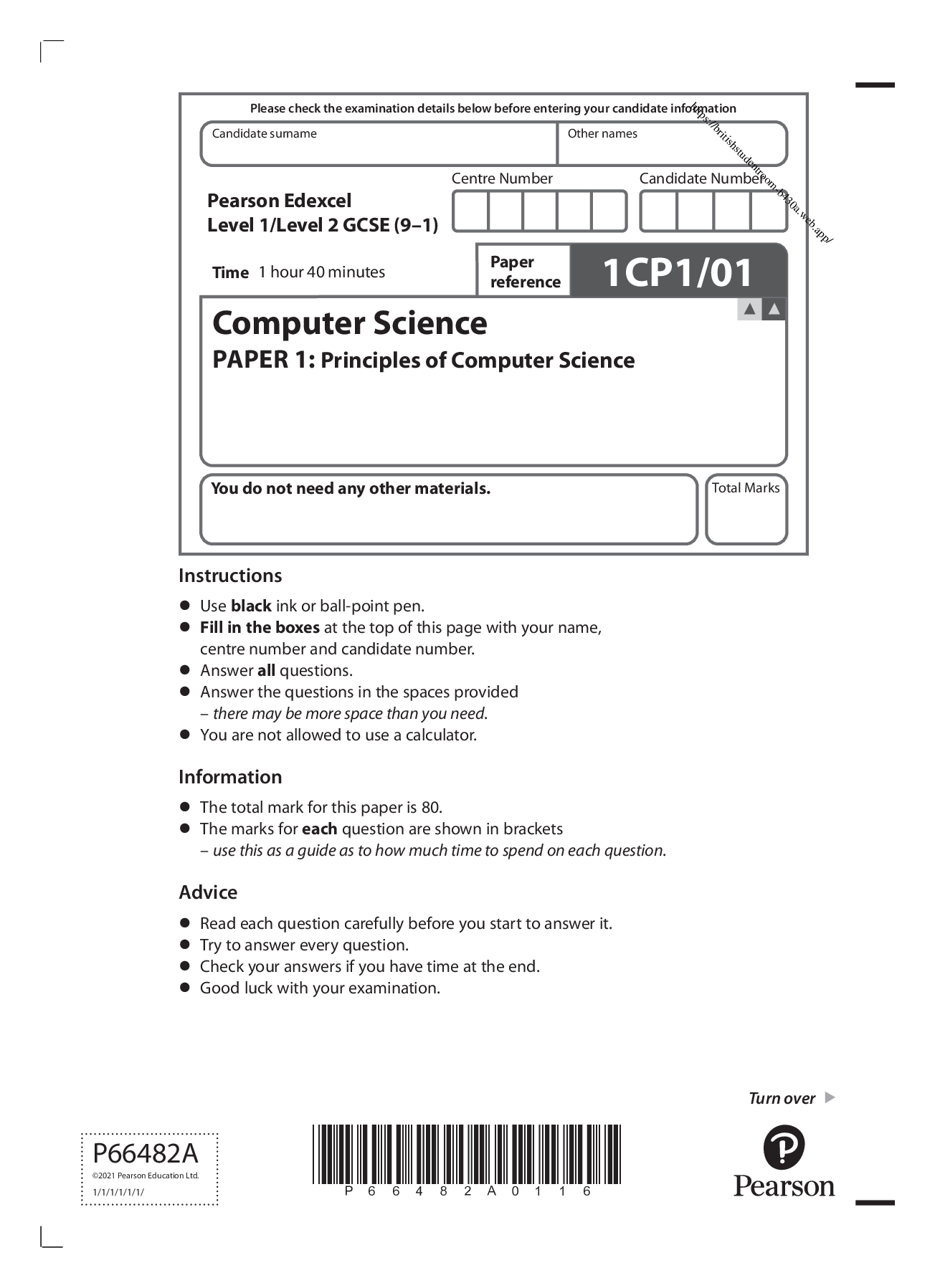
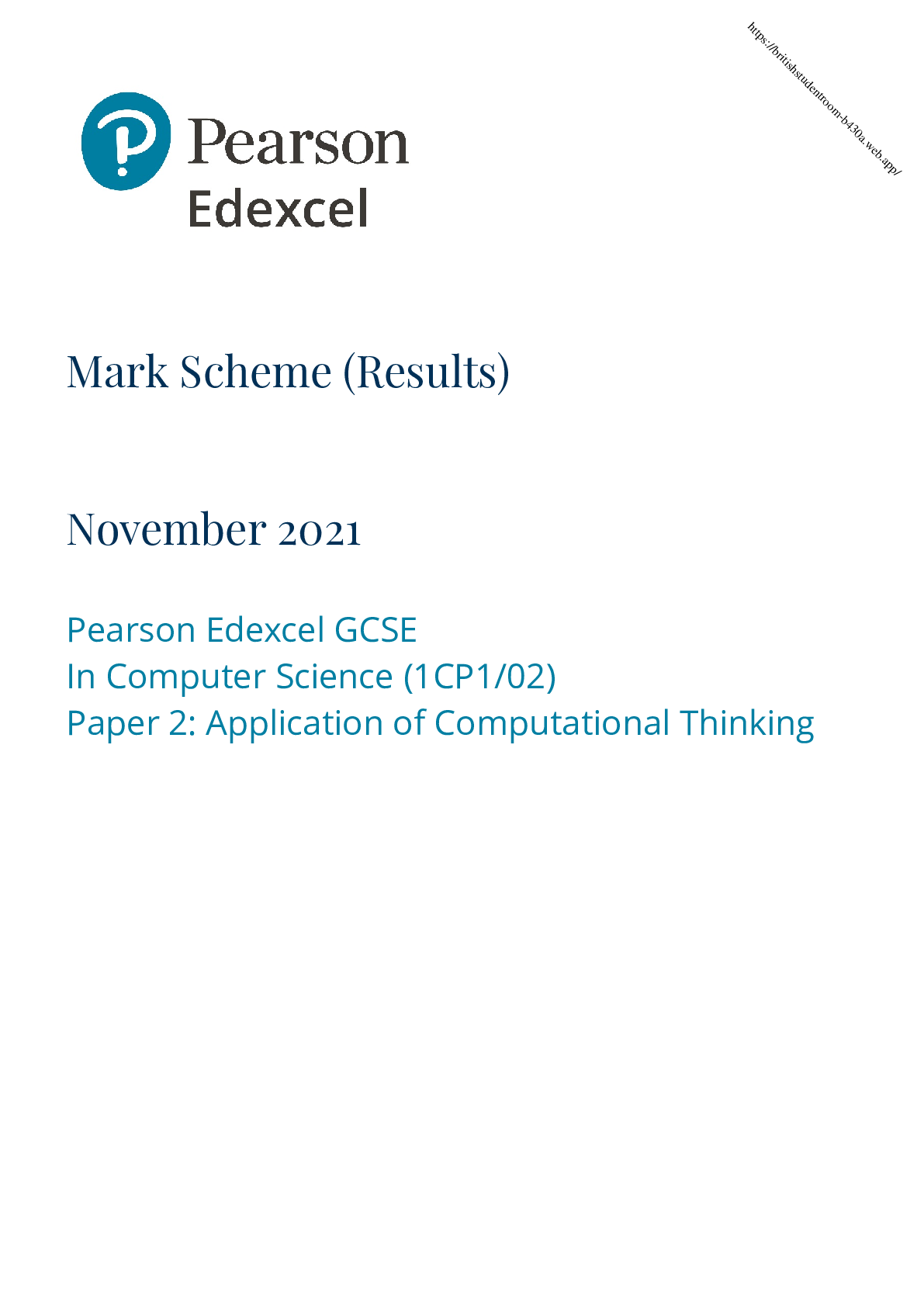

.png)

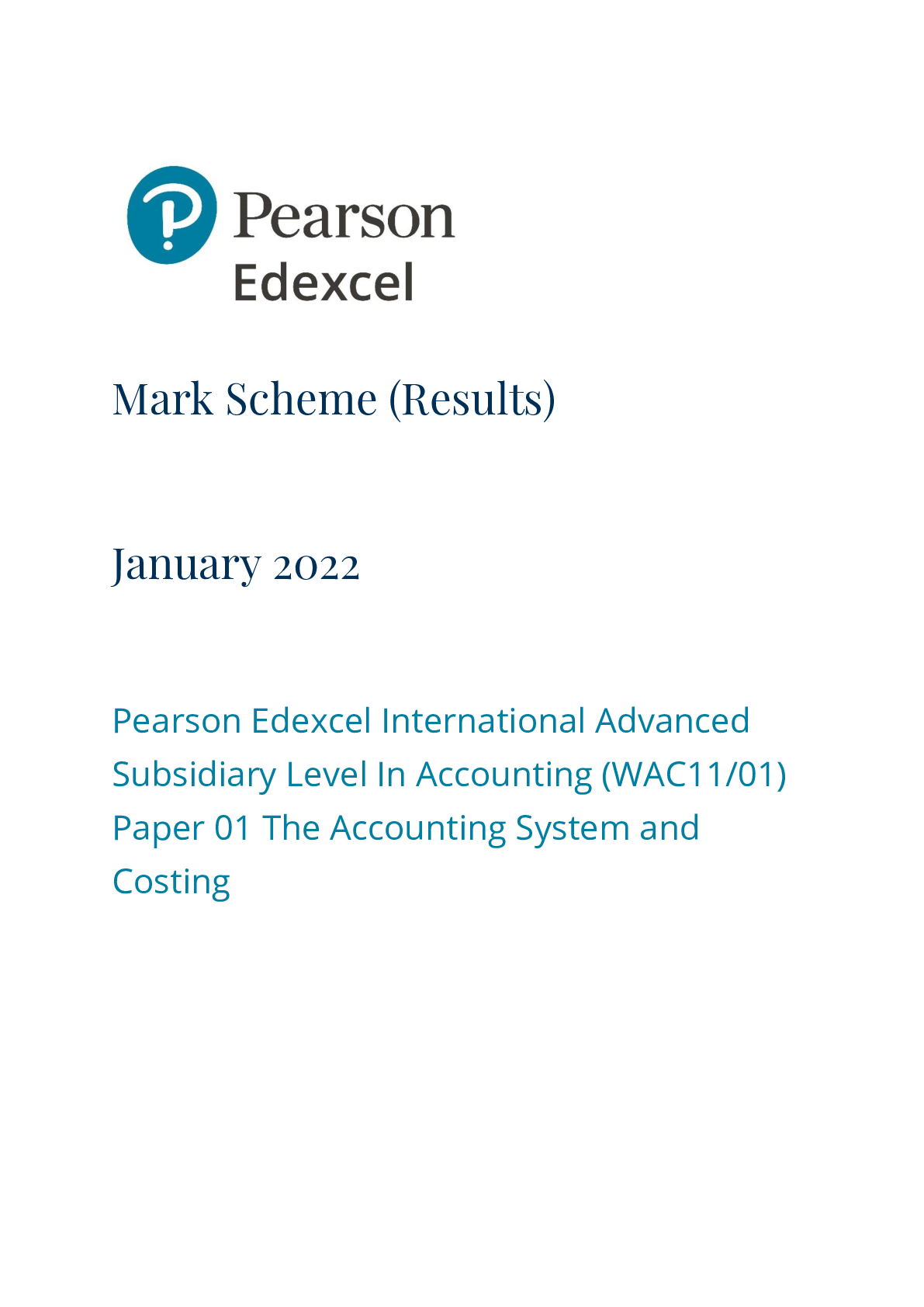
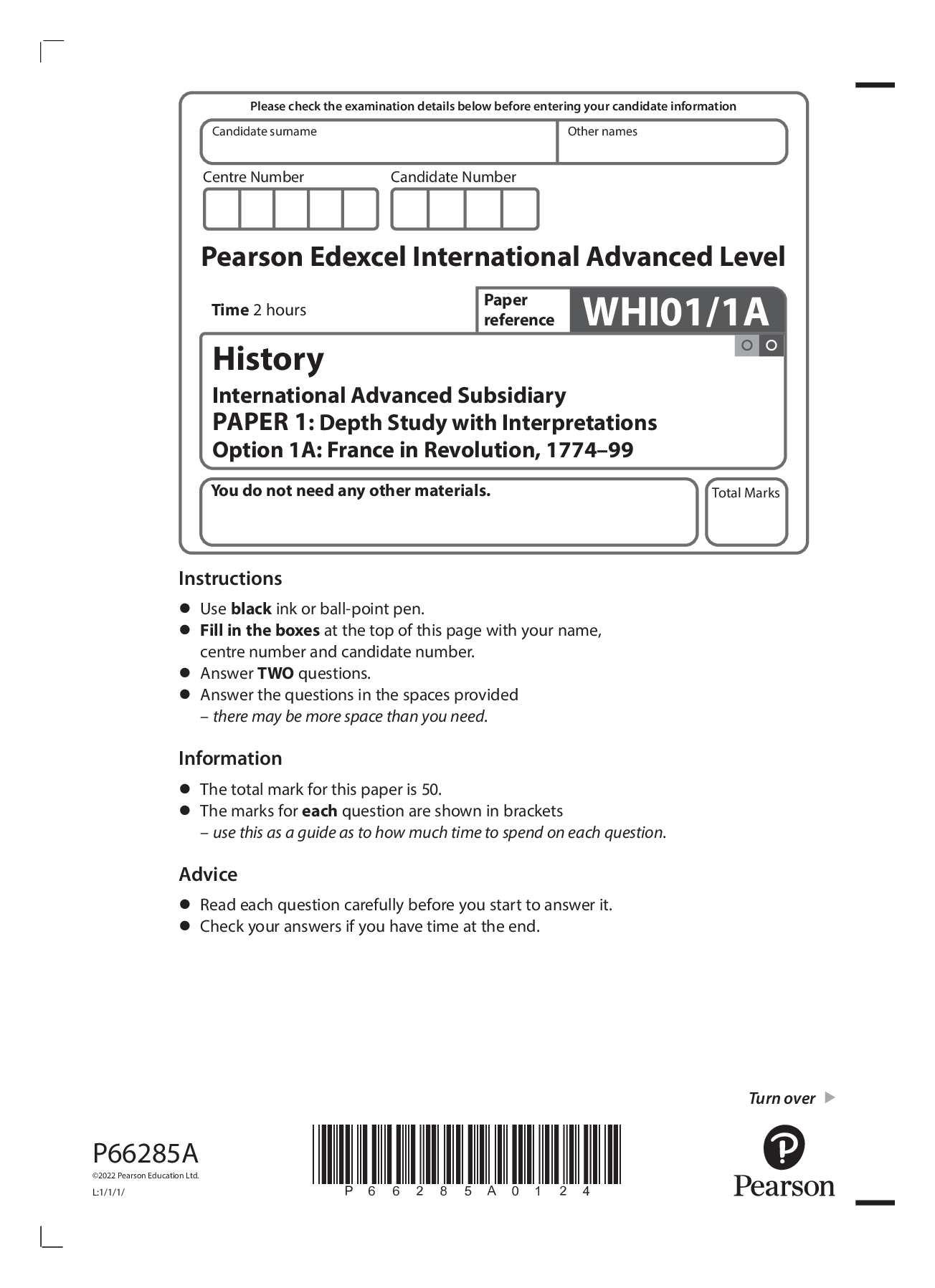


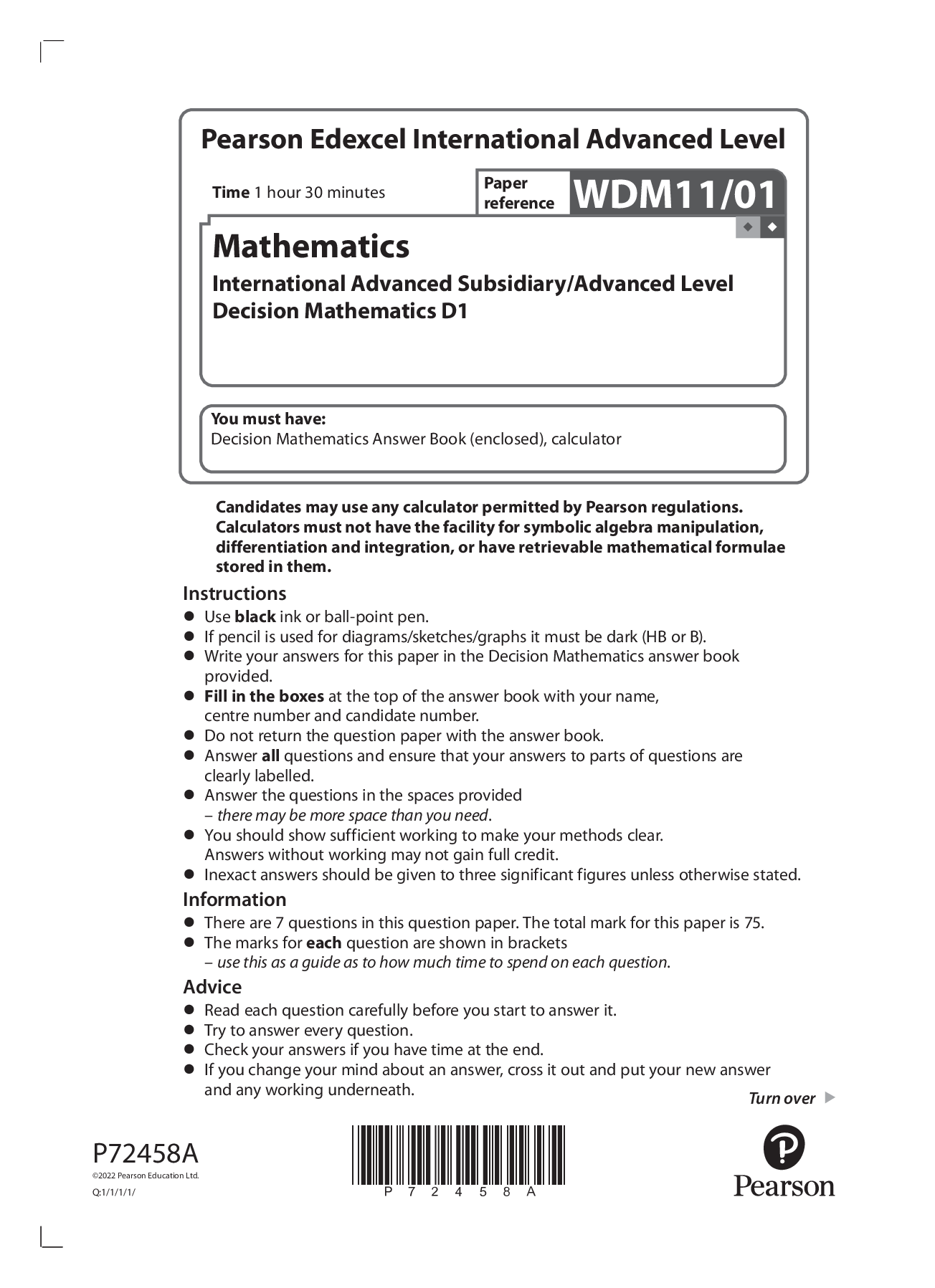
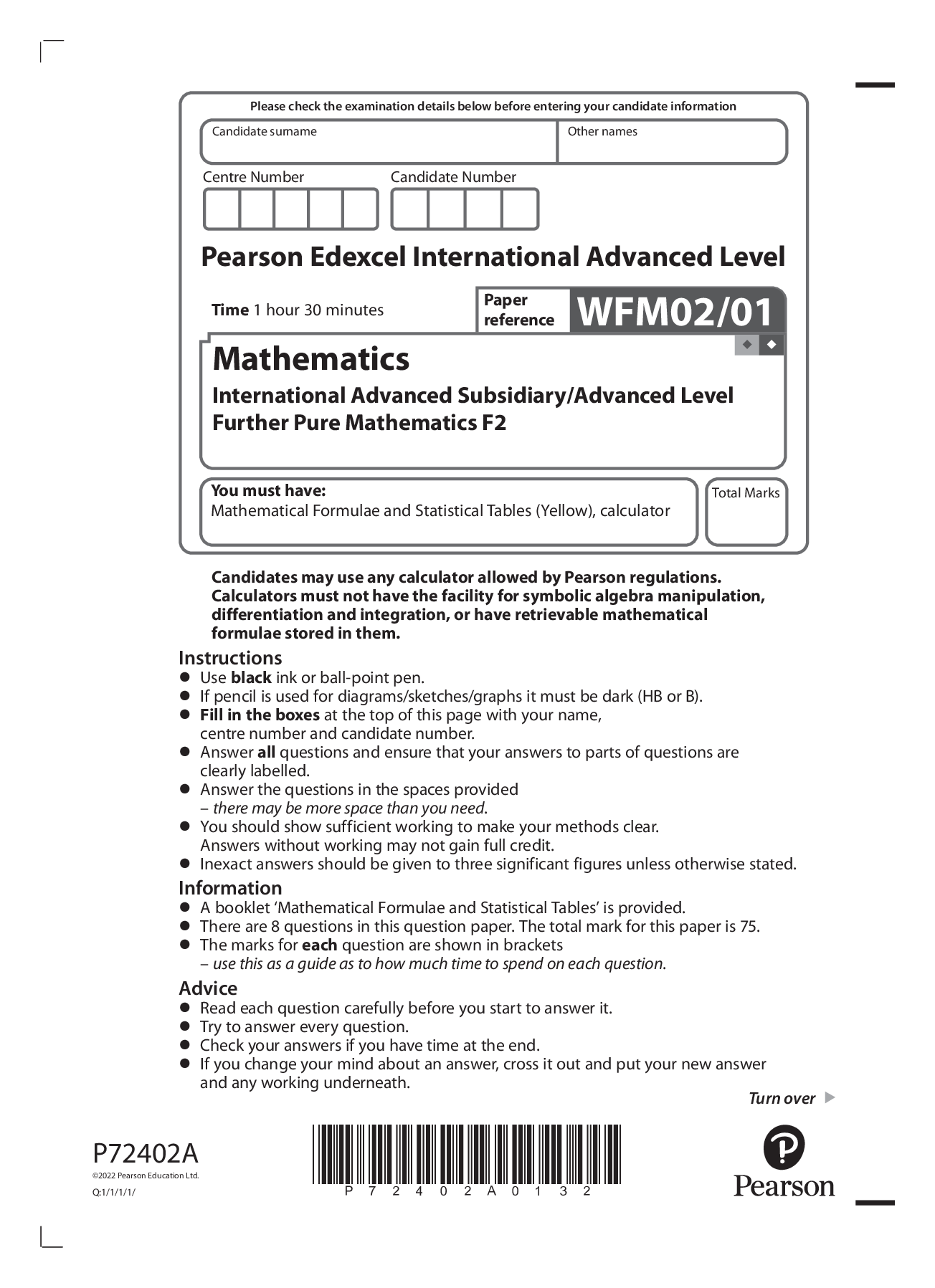
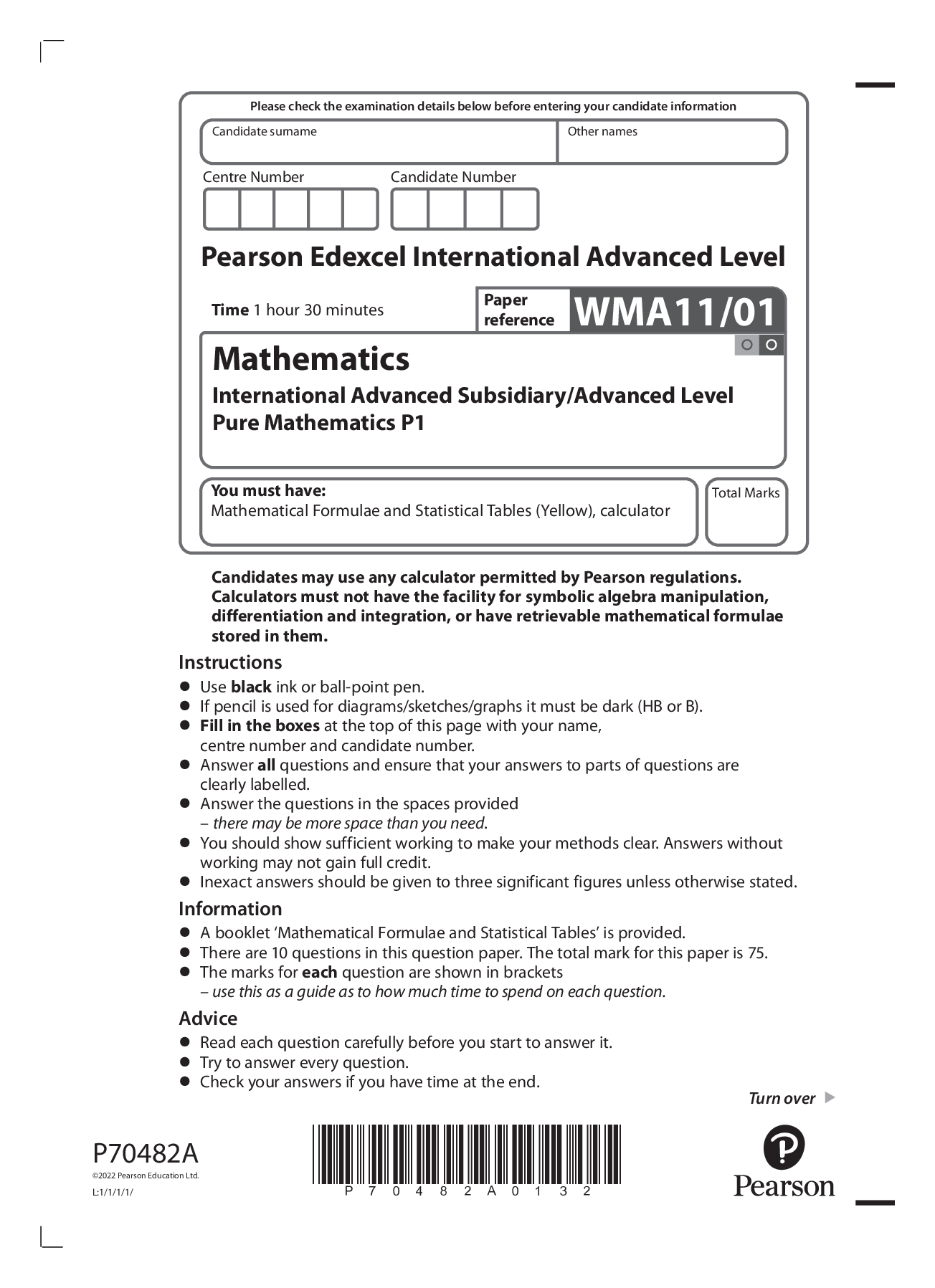
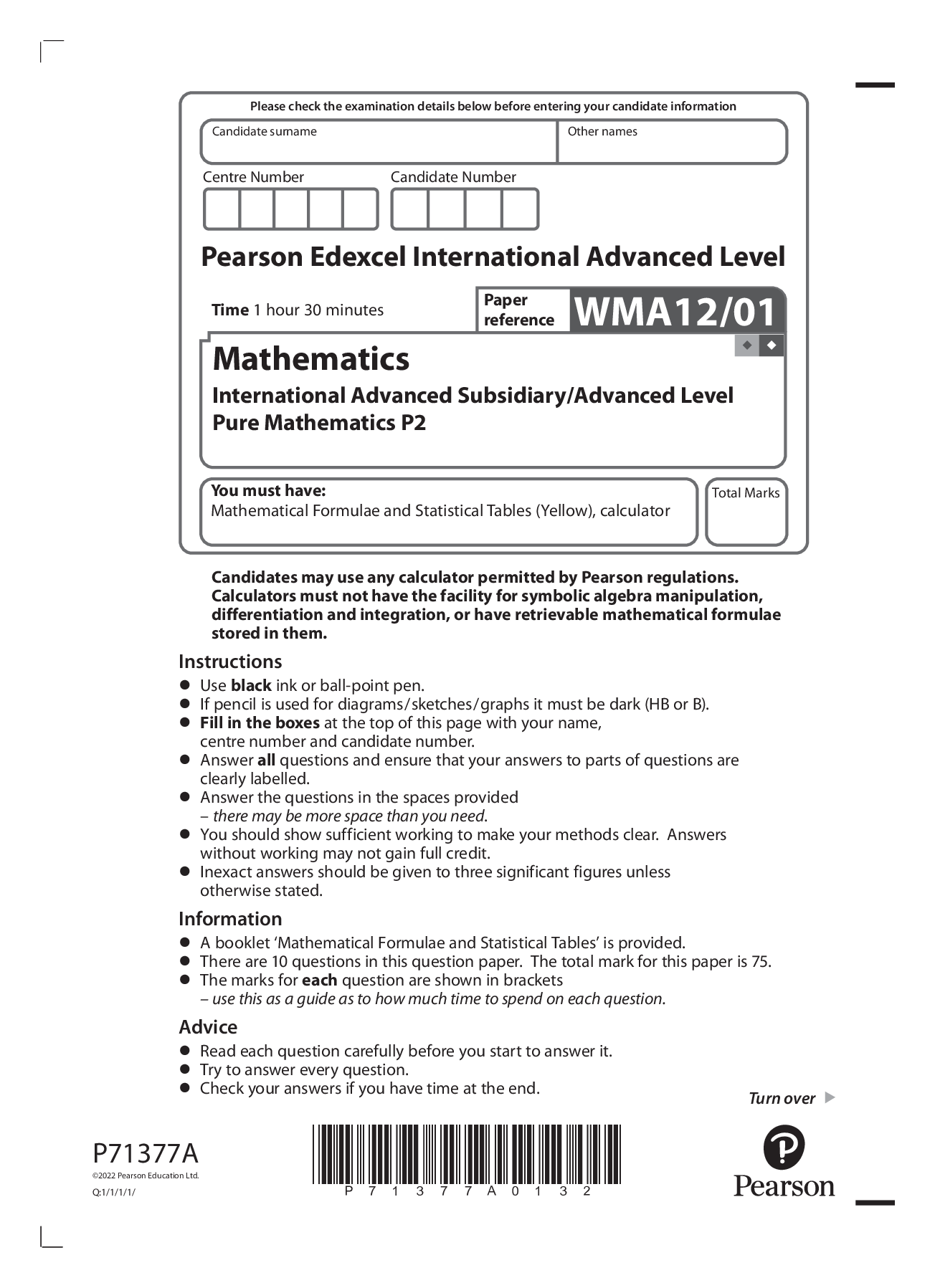

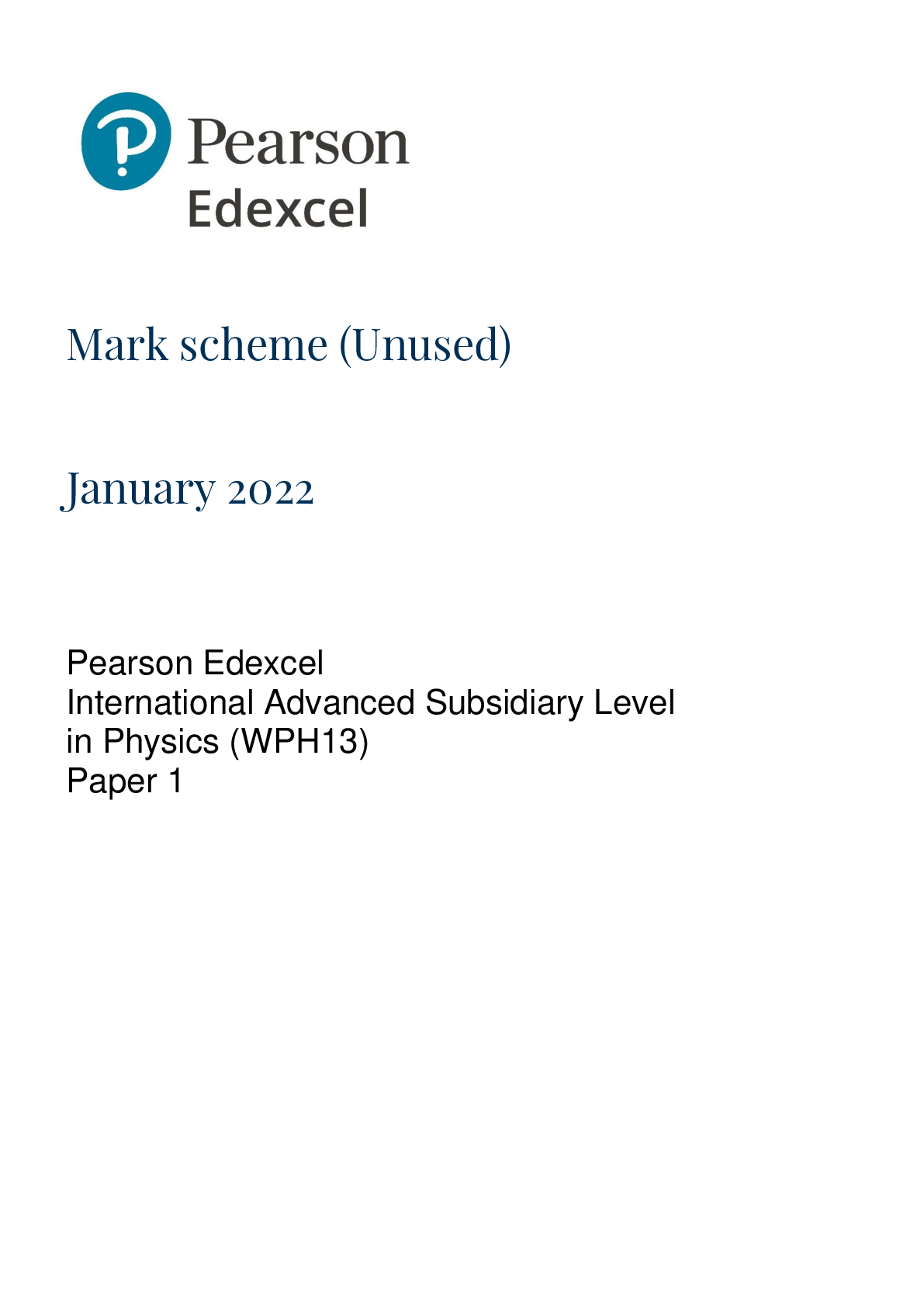
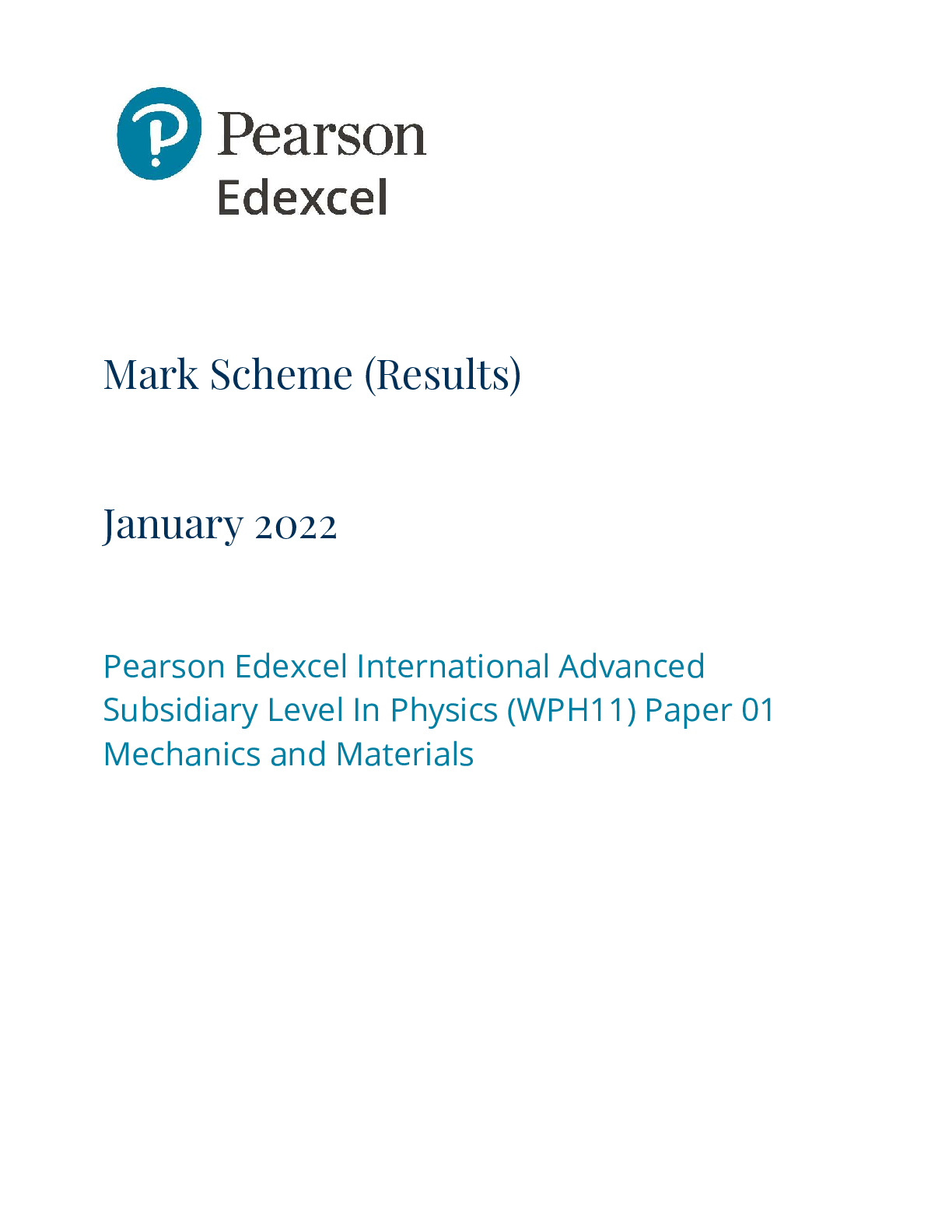

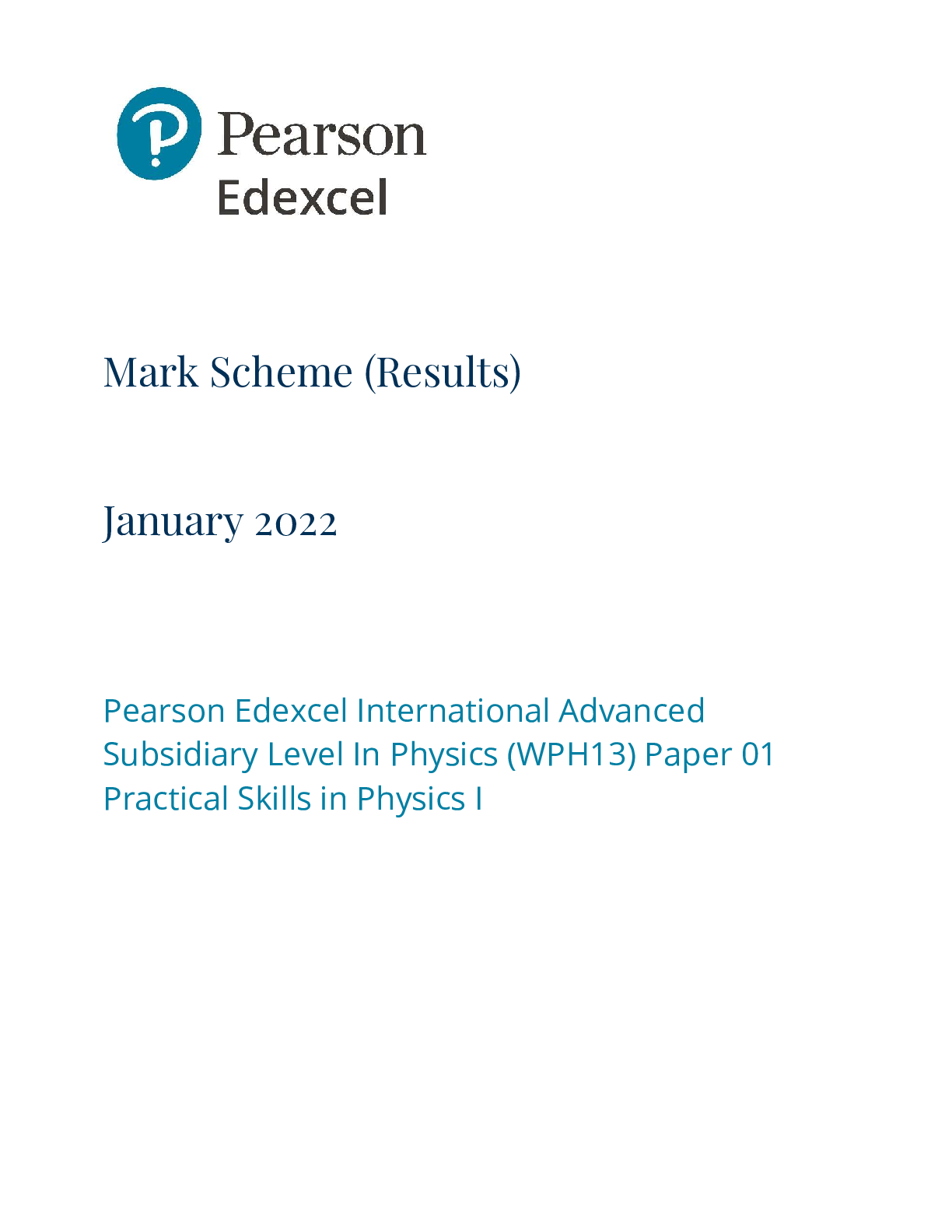
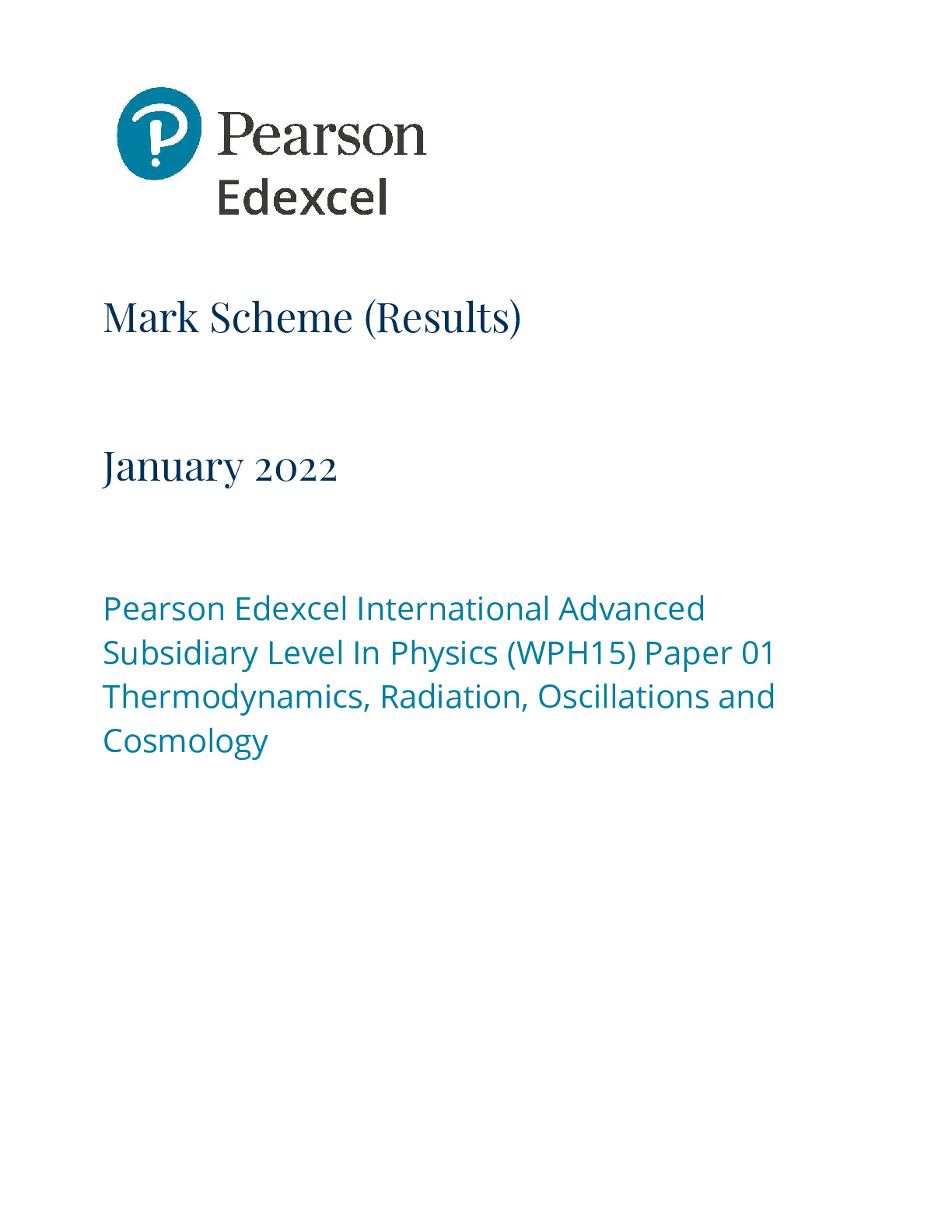

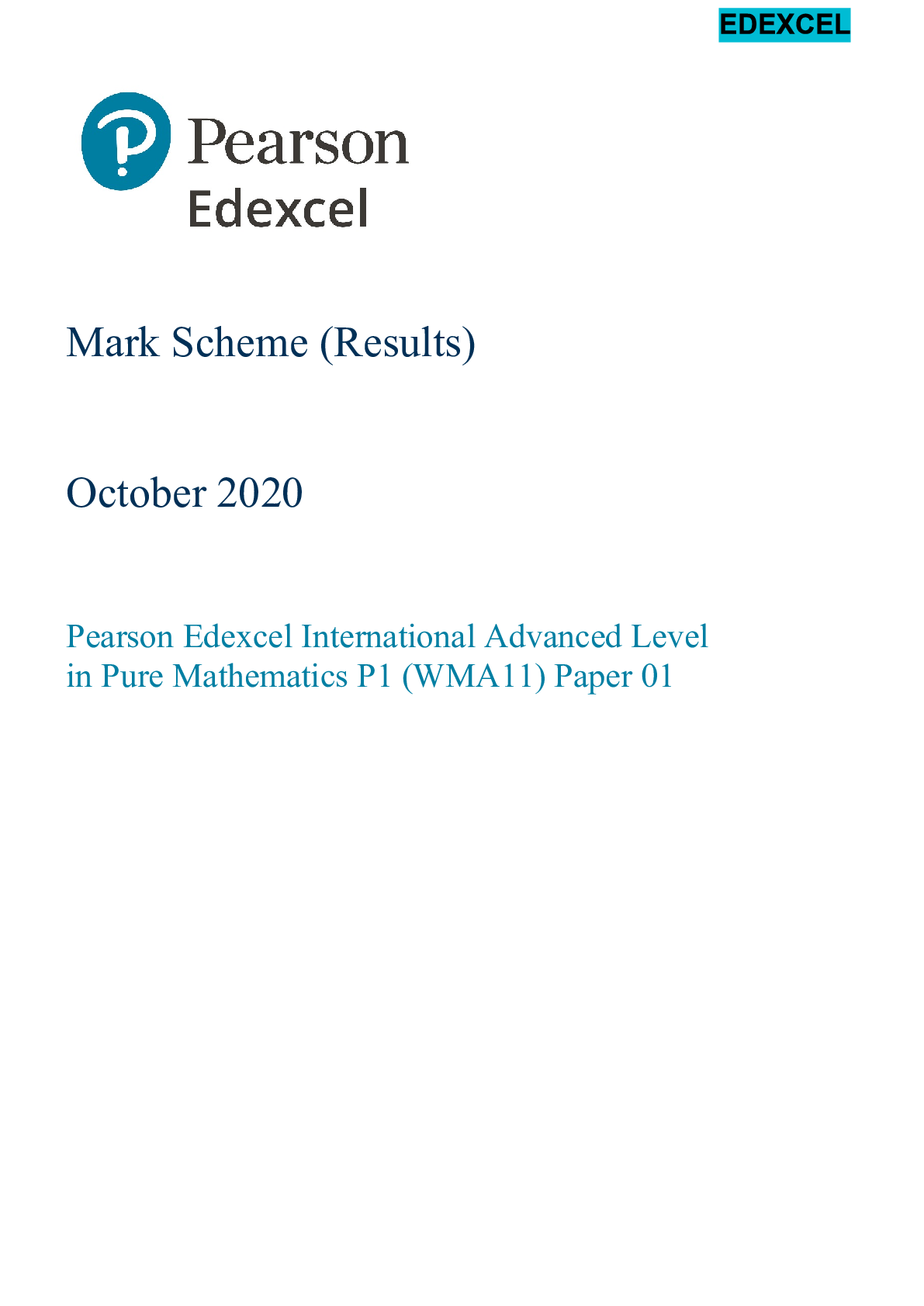
.png)

